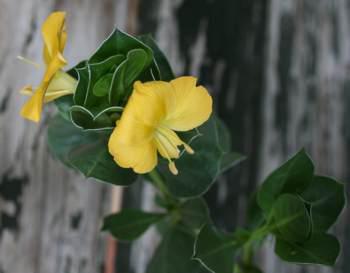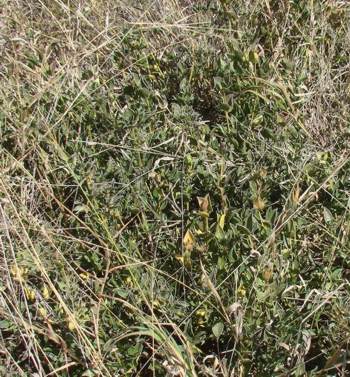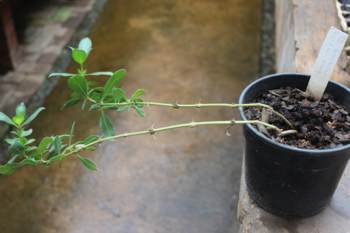Barleria randii
Barleria randii S.Moore
Family: Acanthaceae
Common names: Matopos apricot barleria
Introduction
This barleria with its orange/yellow flowers and white leaf margins will be an attractive addition to a rock garden.

Description
Description
An armed herb up to 40mm high; auxiliary spines 2-4, clustered. Leaves are ovate (egg-shaped) to broadly elliptic, stiffly leathery with thickened white margins, cuneate (wedge-shaped) at the base, with the leaf tips ending in sharp points.
Flowers orange/yellow, solitary in the upper axils (the angle between the stem and leaf stalk), corolla 2-lipped the upper lip 4-lobed and the lower lip entire. The corolla is subtended by oblong calyx lobes and the corolla tube is cylindrical. Stamens and stigma are brightly coloured. Flowering time is from December to February during which flowers appear sporadically.
Fruit is a capsule, turgid and rounded at the base with the apex ending in a stout solid conical beak. There are two seeds per capsule. Ripe capsules explode when moistened, to distribute the seed.
Conservation Status
Status
Barleria randii is Red Listed as Least Concern.
Distribution and habitat
Distribution description
Occurs in Botswana, Zimbabwe, and in South Africa in North-West and Limpopo provinces. The plants in Limpopo grow in full sun in deep sandy soils.

Derivation of name and historical aspects
History
Named after Dr R.F. Rand, an English medical doctor and one of the earlier collectors in Rhodesia (now Zimbabwe).
Ecology
Ecology
Barleria randii is pollinated by insects and attracts various species of butterflies.
Uses
Use
Barleria randii is recommended as a garden subject. No cultural uses have been recorded.
Growing Barleria randii
Grow
Barleria randii can be propagated both by seed or cuttings.
Collect the seed as the capsules turn brown. Plant seeds in a mixture of equal parts of coarse river sand, good soil and compost (October to February). Place the seed tray in a shady spot and water once a week. Seed germination takes place after 6-10 days. Transplant the seedlings into containers when they are 100mm in size.
Barleria randii is difficult to grow from cuttings. Take semi-hardwood cuttings, 120mm in size, in summer and treat the cuttings with a hormone powder to stimulate root growth. Use a mixture of even parts soil and river sand as a growing medium. Put the container in a shady place and water twice a week. Transplant the rooted cuttings after 3-4 months in a good soil mixture. Expect a success rate of 20%.

Barleria randii thrives in deep sandy soils and does well in full sun. It is a slow grower and takes about two years to become established. There are no specific pests and diseases affecting this species.
References
- http://plants.jstor.org/taxon/barleria.randii
- Plowes, D.C., Drummond, R.B. 1976. Wild flowers of Rhodesia . Longman, Rhodesia.
- Raimondo, D., Von Staden, L., Foden, W., Victor, J.E., Helme, N.A.,Turner, R.C., Kamundi, D.A. & Manyama, P.A. 2009. Red list of South African plants. Strelitzia 25. South African National Biodiversity Institute, Pretoria.
- Retief, E. & Herman, P.P.J. 1977. Plants of the Northern Provinces of South Africa: Keys and diagnostic characters. Strelitzia 6. National Botanical Institute, Pretoria.
Credits
Willem Froneman
Lowveld National Botanical Garden
March 2014
Plant Attributes:
Plant Type: Shrub
SA Distribution: Limpopo, North West
Soil type: Sandy
Flowering season: Early Summer, Late Summer
PH: Neutral
Flower colour: Yellow, Orange
Aspect: Full Sun
Gardening skill: Average
Special Features:
Horticultural zones








Rate this article
Article well written and informative
Rate this plant
Is this an interesting plant?
Login to add your Comment
Back to topNot registered yet? Click here to register.